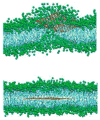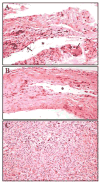Biological interactions of graphene-family nanomaterials: an interdisciplinary review
- PMID: 21954945
- PMCID: PMC3259226
- DOI: 10.1021/tx200339h
Biological interactions of graphene-family nanomaterials: an interdisciplinary review
Abstract
Graphene is a single-atom thick, two-dimensional sheet of hexagonally arranged carbon atoms isolated from its three-dimensional parent material, graphite. Related materials include few-layer-graphene (FLG), ultrathin graphite, graphene oxide (GO), reduced graphene oxide (rGO), and graphene nanosheets (GNS). This review proposes a systematic nomenclature for this set of Graphene-Family Nanomaterials (GFNs) and discusses specific materials properties relevant for biomolecular and cellular interactions. We discuss several unique modes of interaction between GFNs and nucleic acids, lipid bilayers, and conjugated small molecule drugs and dyes. Some GFNs are produced as dry powders using thermal exfoliation, and in these cases, inhalation is a likely route of human exposure. Some GFNs have aerodynamic sizes that can lead to inhalation and substantial deposition in the human respiratory tract, which may impair lung defense and clearance leading to the formation of granulomas and lung fibrosis. The limited literature on in vitro toxicity suggests that GFNs can be either benign or toxic to cells, and it is hypothesized that the biological response will vary across the material family depending on layer number, lateral size, stiffness, hydrophobicity, surface functionalization, and dose. Generation of reactive oxygen species (ROS) in target cells is a potential mechanism for toxicity, although the extremely high hydrophobic surface area of some GFNs may also lead to significant interactions with membrane lipids leading to direct physical toxicity or adsorption of biological molecules leading to indirect toxicity. Limited in vivo studies demonstrate systemic biodistribution and biopersistence of GFNs following intravenous delivery. Similar to other smooth, continuous, biopersistent implants or foreign bodies, GFNs have the potential to induce foreign body tumors. Long-term adverse health impacts must be considered in the design of GFNs for drug delivery, tissue engineering, and fluorescence-based biomolecular sensing. Future research is needed to explore fundamental biological responses to GFNs including systematic assessment of the physical and chemical material properties related to toxicity. Complete materials characterization and mechanistic toxicity studies are essential for safer design and manufacturing of GFNs in order to optimize biological applications with minimal risks for environmental health and safety.
Figures












References
-
- Novoselov KS, Geim AK, Morozov SV, Jiang D, Zhang Y, Dubonos SV, Grigorieva IV, Firsov AA. Electric field effect in atomically thin carbon films. Science. 2004;306:666–669. - PubMed
-
- Ruoff R. Graphene: calling all chemists. Nat Nanotechnol. 2008;3:10–11. - PubMed
-
- Stankovich S, Dikin DA, Dommett GH, Kohlhaas KM, Zimney EJ, Stach EA, Piner RD, Nguyen ST, Ruoff RS. Graphene-based composite materials. Nature. 2006;442:282–286. - PubMed
-
- Su FY, You C, He YB, Lv W, Cui W, Jin F, Li B, Yang QH, Kang F. Flexible and planar graphene conductive additives for lithium-ion batteries. J Mater Chem. 2010;20:9644–9650.
-
- Paek SM, Yoo E, Honma I. Enhanced cyclic performance and lithium storage capacity of SnO2/graphene nanoporous electrodes with three-dimensionally delaminated flexible structure. Nano Lett. 2009;9:72–75. - PubMed
Publication types
MeSH terms
Substances
Grants and funding
LinkOut - more resources
Full Text Sources
Other Literature Sources
Miscellaneous

